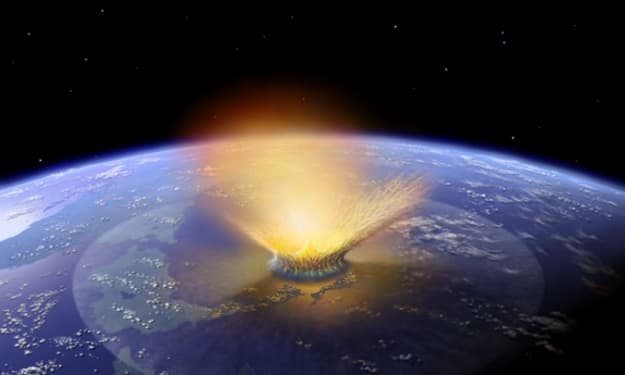What Is Present Age Of Earth
What Is Present Age Of Earth

It is assumed that Earth's accretion began with the formation of calcium and aluminum-rich inclusions in meteorites. These rocks formed the guts of the planet in which uranium atoms were trapped.
It is difficult to determine the exact age of the oldest rocks on the Earth exposed in the surface, because they are assembled minerals of different ages. Measuring how old meteorites are is the most reliable measure because the Earth's older rocks are broken up and built up over time by the movement of plate tectonics, which predicts the Earth's age. However, it is not known how long the Earth's accretion took and predictions from various accretion models range from a few million years to 100 million years ago making the age difference between the oldest rocks on Earth very difficult to determine.
The best estimate of the Earth age is based on radiometric dating of fragments of the iron meteorite Canyon of Diablo. From these meteorites, scientists can calculate the relative abundance of elements in the form of radioactive uranium, which has decayed over billions of years.
Because ancient terrestrial rocks are unlikely to be remnants of our planet's original crust, scientists have had to look for older materials in the solar system that have not changed as much as rocks on Earth. Researchers studied ancient rock samples not only from Earth and the moon, but also from meteorites formed in the early solar system.
In 1953, Clair Cameron Patterson, a famous geochemist at the California Institute of Technology, measured the ratio of lead isotopes in samples of meteorites in order to set tight limits on the earth's age. He used lead and lead data for several meteorites, including the Canyon of Diablo meteorites, and published his data in 1956. The technique was further refined in the 1960s, and as tests were conducted on a range of materials and became more and more sophisticated, researchers pushed back the age of the Earth and began to rotate about 4.5 billion years ago.
The lead isotope isochronous diagram shows the data Clair Cameron-Patterson used to determine the age of the Earth in 1956. Lead isotopes are used to date rocks and provide the best evidence of Earth's age.
Dalrymple (2004) cites an example of a lead isotope date that indicates the age of the Earth at 4.5 billion years. Scientists were able to determine a probable age for the solar system by calculating the age of the Earth by assuming that the Earth and the rest of the solid bodies in the solar system were of the same age at the same time (Watson, 1997). The generally accepted age of Earth 45 billion years is the result of radiometric dating of lunar rocks and meteorites as well as dating methods based on models by Gerling, Holmes and Houtermans.
Current estimates put the age of the planet Earth at 4.54 billion years, by giving or taking 50 million years, because it, like other bodies in the solar system, was formed from a cloud of dust and gas that collapsed under gravity. The universe is believed to be around 13.77 billion years old and the Earth is probably younger. The Earth's age is 4.6 billion years because the age of meteorites in Earth system is the last time the isotope composition led to a uniform solar system and the time when solid bodies formed within the solar nebula (Dalrymple 1991 ).
Since Earth does not have a birth certificate, there are no records of its formation, meaning that scientists have spent hundreds of years determining the age of the planet. Scientists have estimated that the Earth is about 4.54 billion years old by dating rocks from the planet and changing the crust of its neighbors like the moon and visiting meteorites. The Earth is about 50 million years old, with errors from about 50 million years to twice that.
It has been a long scientific journey to know the age of the Earth with such amazing precision. Scientists have made several attempts to date the planet Earth over the past 400 years. They have tried to predict the age of the planet based on changes in sea level, the time it takes for the planet and the sun to cool down, and the current temperature and salinity of the oceans.
In 1862, physicist William Thomson, better known as Lord Kelvin, concluded that the earth was between 20 and 400 million years old, based on calculations for how long it takes to cool down to a molten state. In 1921 Arthur Holmes showed that radiometric dating was a valid method of ageing the rock, suggesting that the planet was only a few billion years old.
Since the 1960s, radiometric dating has become the predominant method for measuring the age of rocks. The physical process of radioactive decay has provided geoscientists, anthropologists and evolutionary biologists with their most important method for determining the absolute age of rocks and other materials (Dalrymple 1991; Dickin 2005).
The presence of all three of these lead isotopes can be used to generate a powerful tool for age calculations. Radiometric dating works because radioactive elements decay in predictable ways, like a normal ticking clock. Although questions have been raised on the speed at which the team and other groups are doing this, lead isotope is considered the most reliable method of dating the Earth and has an approximate age of 4.5 billion years.
This model led to the development of isotopes, in which two isotopes are plopped against each other to estimate the age of minerals and rocks. This method uses 206Pb and 207Pb lead isotopes, which are by-products of radioactive decay and are normalized to 204Pb.
Soddy and Sir William Ramsay determined the speed at which radiotonium produced alpha particles, and Rutherford suggested that the age of a rock sample could be determined by measuring its Helium concentration. With this technique, he dated the rocks he owned to an age of 40 million years.
Only when science developed more means of estimating the age of the Earth did this become available. In 1900, John Joly calculated the rate at which the oceans accumulated salt through erosion, and estimated that it was 100 million years old, an age now estimated at about 2.5 billion years. By the 1920s, the Earth Age had grown to about 3 billion years, making it the oldest in the universe, estimated to be 1.8 billion years older.
About the Creator
Enjoyed the story? Support the Creator.
Subscribe for free to receive all their stories in your feed. You could also pledge your support or give them a one-off tip, letting them know you appreciate their work.





Comments
There are no comments for this story
Be the first to respond and start the conversation.